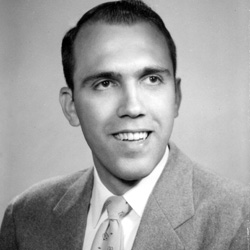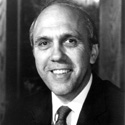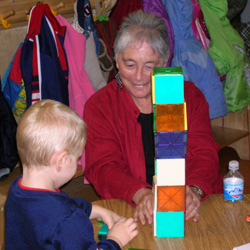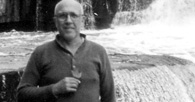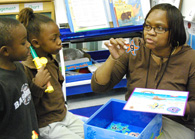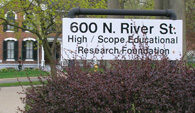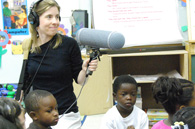 |
The Perry Preschool Project is one of the most famous education experiments of the last 50 years. The study asked a question: Can preschool boost the IQ scores of poor African-American children and prevent them from failing in school? The surprising results are now challenging widely-held notions about what helps people succeed — in school, and in life.
A New Idea
The Perry Preschool was the idea of a man named David Weikart. He was a school system administrator in the small city of Ypsilanti, Michigan back in the late 1950s. When he took the job, he was shocked to discover how many poor African-American children were doing badly in school. A lot of them were being assigned to special education classes, getting held back, and failing to graduate from high school.
Weikart wanted to do something about it, but school officials did not share his enthusiasm. They didn't want him changing things, messing around in their schools.
So rather than change the schools, Weikart decided to invent a new kind of school — a pre-school for 3- and 4-year-olds. His hope was that preschool could boost children's IQs.
This was a radical notion. Most people believed everyone was born with a certain amount of intelligence, a quotient, and it never changed. They had faith in IQ tests to measure intelligence. And they thought intelligence mattered a lot, that it was the key to success in school, and life.
And IQ tests had a lot of power back then. Children with low IQ scores were usually shuffled off to special education classes where no one expected them to learn much. That's what was happening to a lot of African-American students. It's what Weikart was trying to avoid by giving them an early boost in preschool.
But putting such young children in school was a radical idea, too. There was no such thing as preschool in the late 1950s. There were nursery schools for families who could afford tuition, but nursery schools were all about play. They focused on social and emotional development only. A lot of educators thought 3- and 4-year-olds were too young too learn, and they certainly couldn't handle real school - kids that little couldn't sit still at desks and listen to a teacher all day.
But the Perry Preschool was going to be a new kind of school. Weikart was experimenting with a new way of thinking about education.
In the old view, children are vessels to be filled with knowledge and information. In the new view, children are not vessels at all. They are active participants in their own education, instinctually curious, motivated to learn. The teacher's job is to engage students, not tell them what to do.
And unlike nursery school, the Perry Preschool would focus on cognitive development — stimulating children's brains, increasing their vocabulary, teaching them letters and numbers.
There was no evidence this would boost IQ or help children do better in school. So Weikart decided to set up his preschool as a scientific experiment. He would find a group of poor, African-American children with low IQ scores and put half of them in preschool. Then he'd follow all of them for a few years to see if there were any differences between the two groups. He was trying to answer the question, does preschool work?
The Perry Preschool Begins
The Perry Preschool opened its doors in October of 1962.
"I would do whatever we needed to do," says former teacher Evelyn Moore, "to prove that this many African-American children were not retarded."
"We tried everything," says former teacher Louise Derman-Sparks.
Their idea was to focus on cognitive development, but to do it all through hands-on activities and play.
"It was never directed teaching where we sat them around a table with paper and pencil and told them to check worksheets," says Derman-Sparks. "It was always in the framework of children actively learning."
They believed that education should be about children learning to explore their own ideas and interests.
"We did a lot of writing and making stories with the children," says Moore. "And there would be puzzles, and we would have different levels of puzzles because we were [interested] in trying to get children into more complex ways of dealing with their environment."
The Perry Preschool continued for five years, with a new group of children entering each fall. Most children went to the preschool for two years. At the end, they took IQ tests again.
When the first group of test results came back, the teachers and researchers were elated. The children had gained an average of 15 points — enough to keep a lot of them out of special education. There were other preschool experiments going on at this time, and they were showing IQ gains too.
And then in 1965, President Lyndon Johnson announced an ambitious new federal preschool program called Head Start.
There was a huge amount of hope that Head Start could solve poverty by making poor children "smarter." And the early evidence was encouraging. Children who went to Head Start gained an average of 10 points on IQ tests.
But Head Start was controversial from the start, and soon critics were calling for a large-scale evaluation to prove it really worked. And in the spring of 1969, soon after the inauguration of President Richard Nixon, a damning report about Head Start was released. It showed the IQ gains from Head Start did not last. They "faded out" after just a few years.
Continue to part 2 (of 2)
Download the radio program, or read the transcript.

The Perry preschool study has spanned more than 40 years and turned up a treasure trove of information about what makes children succeed in school — and about the very nature of intelligence. To provide more detail, American RadioWorks prepared an ebook on the history and implications of the study. You can read it online, print it up, or download it to your mobile reading device.
Perry Preschool founder David Weikart was a bit of a radical, a free-thinker, a man ahead of his time.
There is a lot of research about preschool. But three studies stand out because they examine the long-term effects of preschool on people's lives.
What makes a preschool effective? Research says the key is good teachers. A program in northeastern Florida is trying to improve preschool by providing more training to teachers.
The official title of the famous Perry study is "The HighScope Perry Preschool Study." People sometimes ask: Why is it called HighScope?
If not for the Perry Preschool, the Head Start program might not exist today.
Nearly 50 years after it began, the Perry Preschool Study is still going. It continues to provide evidence that preschool can have long-lasting positive effects on people's lives.
Perry Preschool teachers Evelyn Moore and Louise Derman-Sparks share what they remember about the famous preschool and why they think it had such an impact on the children's lives.
See a timeline of key events in the history of the Perry Preschool Study and the preschool movement in the United States.
Producer Emily Hanford wonders how Perry Preschool participants think preschool affected their lives.
Para leer este reportaje en español, oprima aquí.
Support for Early Lessons comes from The Spencer Foundation.
